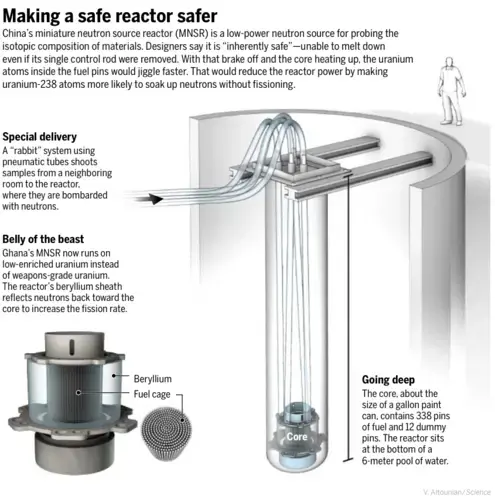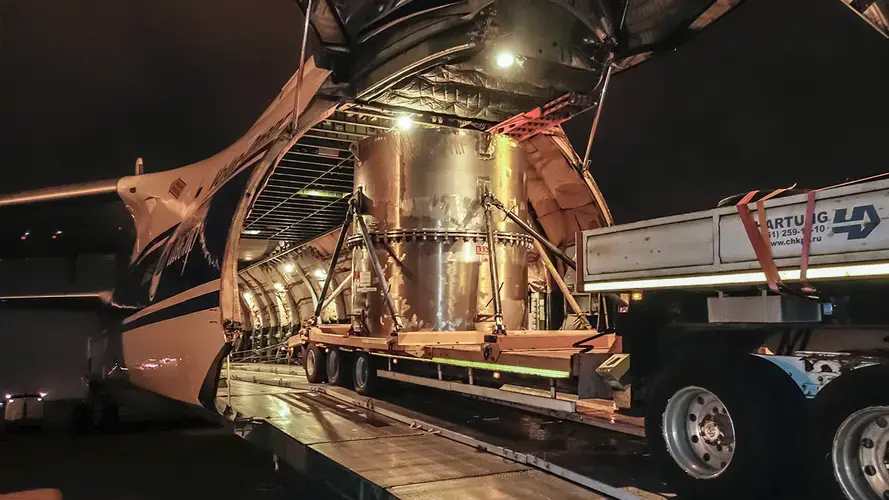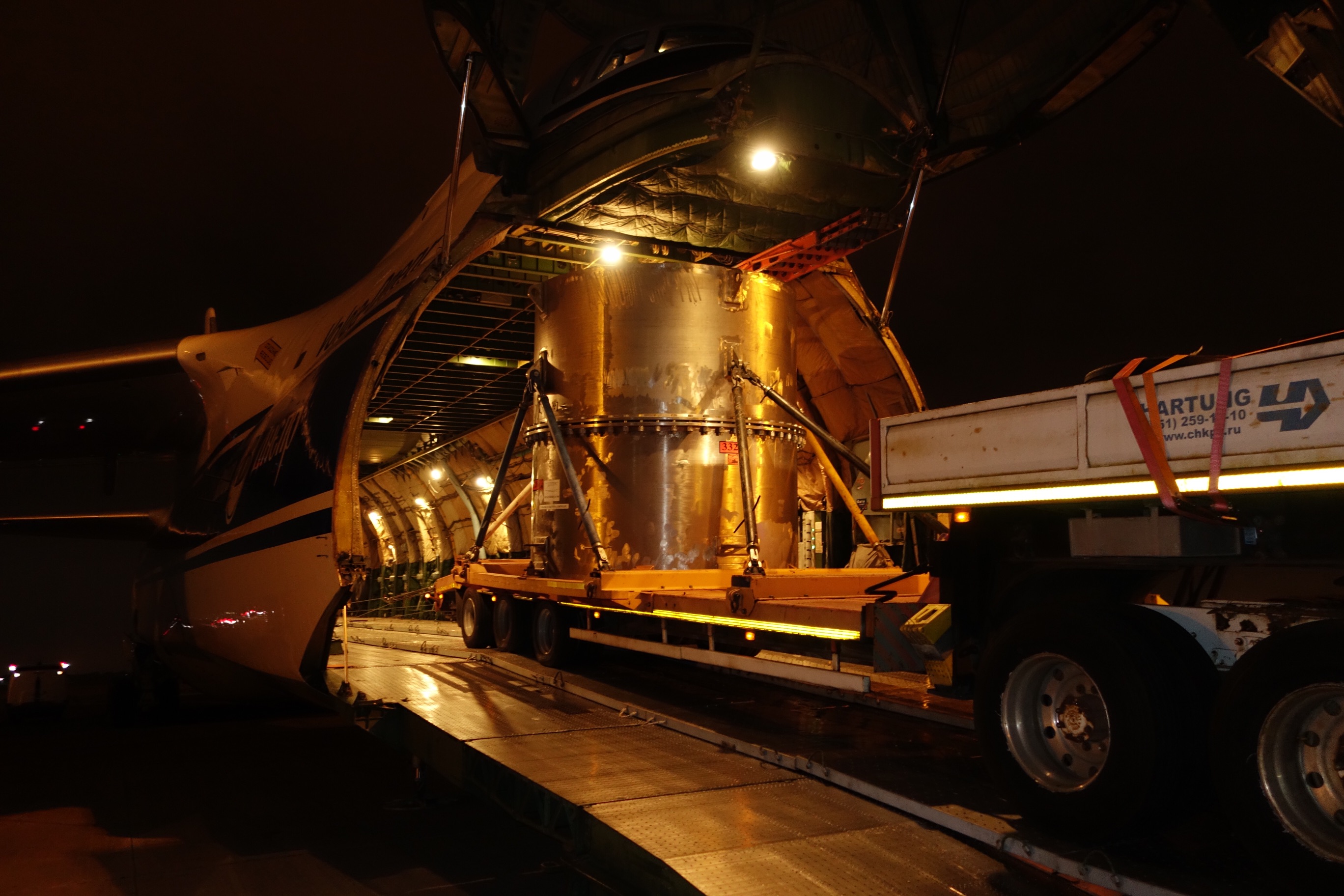
ACCRA AND BEIJING—Dan Peng steps onto a narrow steel frame just above a 6-meter-deep pool, which holds a nuclear reactor about to go critical. Clad in a lab coat with a pocket radiation dosimeter, sweating in the stifling reactor hall here on the outskirts of Ghana's capital, the young nuclear physicist edges out to a tube jutting above the water's surface. He grabs a cord leading out of the tube and reels it up, hand over hand, until a cigar-shaped capsule emerges—a packet of neutron-absorbing cadmium. It's the last of three that were immersed in the pool as a safety measure, to ensure that the reactor's new low-enriched uranium (LEU) core did not achieve a self-sustaining fission reaction—criticality—before the team was ready.
At the edge of the pool, several other physicists and engineers, colleagues of Peng's at the China Institute of Atomic Energy (CIAE) in Beijing, huddle behind a bank of instruments. On one digital display, numbers change in a blur as the neutron count shoots up, then levels off. Now, the only bulwark against criticality is a single control rod piercing the heart of the reactor.
"We're ready," says a smiling Li Yiguo, a CIAE nuclear physicist and leader of a landmark effort in nuclear nonproliferation at the Ghana Research Reactor (GHARR-1). Li asks a colleague to summon dignitaries to mark the culmination of a 10-year odyssey to remove GHARR-1's highly enriched uranium (HEU) fuel—weapons-grade material—and replace it with LEU, which cannot be used for a nuclear bomb without further enrichment.
The operation, which took place in July at the Ghana Atomic Energy Commission in Accra, is a milestone in a dogged effort since the end of the Cold War to remove enriched uranium and plutonium from countries that do not have nuclear weapons. Spearheaded by the United States and the International Atomic Energy Agency (IAEA) in Vienna, the initiative took on added urgency after the 9/11 attacks, out of fear of al-Qaida or another terrorist group laying hands on nuclear materials. Small, HEU-fueled research reactors, including GHARR-1 and four other Chinese-made miniature neutron source reactors (MNSRs) operating in the Middle East and Africa, were a high priority. But reengineering an MNSR's core—a cylindrical array of 350 fuel and dummy pins that is a little larger than a gallon paint can—to run on safer fuel posed unique challenges.
Chinese and U.S. nuclear experts spent a decade plotting out the Ghana operation, sharing expertise and working at each other's labs. "No question, we were able to collaborate very, very well on the MNSR conversion," says Ernest Moniz, CEO of the Nuclear Threat Initiative (NTI), a think tank in Washington, D.C., and former secretary of the U.S. Department of Energy (DOE). The process strengthened a bond that is quietly developing between nuclear scientists in the United States and China. "It's very important for building trust," says Hui Zhang, a nuclear policy analyst at the Belfer Center for Science and International Affairs at Harvard University.
In 1999, relations between Chinese and U.S. nuclear scientists entered a tailspin after the U.S. Congress, in a high-profile report, accused China of stealing nuclear weapons secrets from DOE's national laboratories. China denied the allegations, and U.S. nonproliferation experts cast doubt on them. Nevertheless, the accusations torpedoed a nascent technical exchange program between U.S. and Chinese weapons scientists.
But now, even as the two countries are embroiled in trade disputes and tensions over the South China Sea and North Korea's nuclear program, collaborations between their nuclear scientists are intensifying. Last year, China opened a Center of Excellence (COE) in nuclear security in Beijing that's filled with top-of-the-line instrumentation for combatting nuclear smuggling and terrorism; Chinese and U.S. physicists work together there to hone measures for protecting nuclear facilities and analyzing interdicted nuclear materials. Under the 2015 Iran nuclear deal, U.S. and Chinese scientists are helping counterparts in Iran reconfigure a heavy water reactor in Arak so it can no longer produce significant quantities of plutonium. And the research reactor conversions will continue. Next up is an MNSR in Nigeria in spring 2018, followed by reactors in Iran, Pakistan, and—when conditions permit—Syria.
The MNSR conversions "show real leadership on the part of the Chinese," says David Huizenga, acting deputy administrator for defense nuclear nonproliferation at DOE's National Nuclear Security Administration (NNSA) in Washington, D.C. They are part of a "very important partnership" in nuclear security, he says, in which something unthinkable only a few years ago is taking place: Chinese and U.S. weapons scientists are finding ways to work together.

Early in the Cold War, China's nuclear program was, to the West, a black box. Its leaders trained in the United States and United Kingdom before World War II, but the Soviet Union provided critical materials and technical help in the late 1950s. By 1960, Sino-Soviet relations were fraying, but China's program was well underway; it detonated its first atomic bomb in 1964.
As relations between China and the United States warmed in the 1980s and the two nations saw the Soviet Union as a common adversary, their nuclear scientists started a wary pas de deux, including low-profile visits to each other's atomic labs. Those initial interactions laid the groundwork for the U.S.-China Arms Control Technical Exchange Program (ACE), launched in 1994 to bring together nuclear scientists from the three chief U.S. weapon labs—Los Alamos National Laboratory, Lawrence Livermore National Laboratory, and Sandia National Laboratories—and their singular counterpart: the China Academy of Engineering Physics (CAEP) in Mianyang, in southwestern China.
The early 1990s were a "huge transition" for China's nuclear scientists, says Nancy Hayden, an international security expert at Sandia in Albuquerque, New Mexico, who took part in the initial exchanges. After China signed the Nuclear Nonproliferation Treaty in 1992, she says, CAEP's privileged but cloistered scientists "suddenly found themselves thrust into roles they had no idea how to fulfill," such as verifying treaty compliance, bringing fissile material safeguards up to international standards, and even helping China develop nuclear power. "They were eager to soak up whatever knowledge we could share," Hayden says.
Obstacles loomed, including the legacy of China's Cultural Revolution of the 1960s and '70s. "There was a whole generation of scientists missing," says Hayden, who recalls a group split between researchers older than 60 with "deep experience" and neophytes under 30. And when the U.S. side insisted on "transparency," she says, the Chinese recoiled. For them, Hayden explains, "transparency" recalled the requirement during the Cultural Revolution to pen "self confessions" and "rat on their families to authorities."
Yet the interactions proved priceless. "This was the only window onto that community. Just building a relationship was a major outcome," Hayden says. In workshops in 1997–98, the United States and China began collaborating on controlling nuclear exports and on technologies for managing fissile materials and verifying compliance with the Comprehensive Nuclear Test Ban Treaty (which neither country has ratified).
Then it all came to a halt.
Even as ACE was building bridges, other parts of the U.S. government were probing allegations of Chinese nuclear espionage. In May 1999, a U.S. House of Representatives committee chaired by Christopher Cox (R-CA) released a public summary of key claims from its classified report from that January. Among the headline-grabbing findings, the Cox report alleged that China had stolen design information on advanced U.S. hydrogen bombs and on a neutron bomb that was never deployed. The report blamed the thefts on a 20-year-long program of espionage—and on the exchanges, which had given China "extensive interactions with scientists" at Los Alamos and Sandia in New Mexico and Livermore in California, and at a fourth national lab, Oak Ridge in Tennessee.
China maintained that its nuclear weapons R&D relied on homegrown expertise and technology. And in a critique released at the end of 1999, four experts at Stanford University's Center for International Security and Cooperation in Palo Alto, California, eviscerated the Cox report's major findings. "There is no evidence presented in any report that Chinese scientific visitors have abused their privilege in visiting the United States," the Stanford quartet wrote. "There is a lot of stuff in the Cox report that just ain't so," says Matthew Bunn, an expert on nuclear proliferation at the Belfer Center. "Whatever may have happened with respect to espionage, I don't think it had anything to do with the lab-to-lab cooperation."
The U.S. government thought it had nabbed one spy: Wen Ho Lee, a Taiwanese-American physicist at Los Alamos whose work included simulating nuclear blasts. In December 1999, a federal grand jury indicted Lee on 59 counts of stealing nuclear secrets on China's behalf. He spent the next 9 months in solitary confinement—as the case against him unraveled. In September 2000, Lee pleaded guilty to one count of "illegal retention" of defense information. In a humbling climb-down, the government dropped the other 58 counts, and Lee successfully sued for damages.

But the damage to relations between Chinese and U.S. nuclear scientists was done: Contacts ceased. "Many Chinese experts felt greatly insulted," says Tong Zhao, a nuclear policy analyst at the Carnegie-Tsinghua Center for Global Policy in Beijing. Zhao says the director of CAEP, Hu Side, felt "there must be an apology from the U.S. side for the lab-to-lab program to be resumed."
Before that could happen, the 9/11 terror attacks occured and the U.S. government suddenly had a new paramount priority in the nuclear arena: securing weapons-grade fissile materials in the far corners of the globe. That offered a new impetus—what Huizenga calls "a different angle"—for bringing Chinese and U.S. nuclear scientists together.
Razor wire in chaotic curlicues festoons the ceiling of a bunker in Beijing that is an unlikely symbol of the renewed collaboration. Its meter-thick walls are designed to shelter "special nuclear materials": weapons-grade uranium or plutonium. As nuclear physicist Xu Zhenhua and a few companions walk into the dim chamber, about the size of a volleyball court, sensors detect the unauthorized entry and a repeated warning in Chinese blares from a loudspeaker.
"Wait, don't go past that line," says Xu, pointing to a yellow stripe on the floor several centimeters away.
"What happens?"
"The wire falls down on you."
"Ouch."
Xu laughs. In fact, he says, the wire "blanket" would normally be lowered to the floor when staff are absent.
The facility, located at COE, is a test bed for measures to foil nuclear thieves. In an operational bunker, if the razor wire failed to deter an intruder, machines would pump the room full of fog. The obstacles are designed to delay intruders for long enough to be caught before they reach three barrels at the center of the bunker—stand-ins for containers of fissile material.
A short walk away is a cavernous hall with artificial weather generators—wind turbines, lightning machines, and sprinklers—for live-fire training of nuclear SWAT teams; a Kazakh squad was put through its paces there last April. Two other buildings house top-of-the-line instrumentation, much of it provided by the United States, for analyzing interdicted nuclear materials.
COE "is such a great opportunity for nuclear security collaboration," says Tam Le, a specialist on physical protection of nuclear facilities at Sandia who has been working at COE to set up simulations and augmented-reality training. For their part, Chinese specialists visiting Los Alamos and other U.S. labs are boning up on techniques for forensic analysis of nuclear materials at COE.
The interactions are paying off. This summer, IAEA ran a round-robin competition, sending identical uranium oxide pellets to COE and 30 other labs around the world for analysis. One challenge was to precisely assay the uranium isotopes, which could shed light on the material's source; on at least one measurement, COE scientists came out tops. The China-U.S. collaboration at COE has grown so tight that DOE won an exception to U.S. law to ship plutonium to COE as a reference standard. "You would not expect that. But it's a very small amount," says Xu, deputy director general of China's State Nuclear Security Technology Center, which runs COE.
At a China-U.S. nuclear security dialogue last spring, China shared proposals for using COE for further joint work in securing radioactive materials and other areas. So far, scientists from CAEP, China's nuclear weapons lab, have not participated. "The potential is there. Time will tell," says Page Stoutland, vice president for scientific and technical affairs at NTI, which has recently brokered informal talks between Chinese and U.S. nuclear weapons scientists. NTI's Moniz is less optimistic. Renewing ties with CAEP, he predicts, "is going to be challenging for the next few years."

Inside the GHARR-1 hall, the reactor with its new LEU core is powering up. Li gives the order to raise the control rod 2 centimeters at a time. Each time, the neutron count jumps, and then levels off. "This has been a long time coming," says Kwame Aboh, who heads Ghana's Nuclear Regulatory Authority.
The painstaking collaboration began when scientists from CIAE and Argonne National Laboratory in Lemont, Illinois, did rounds of meticulous calculations to determine how much LEU would be required to match the old core's neutron flux. That would ensure the reactor remains a powerful tool for analyzing materials and geological samples. "The point was not just to remove the HEU, but to maintain the facility's scientific capabilities," says Peter Hanlon, assistant deputy administrator for NNSA's office of material management and minimization, who led the U.S. delegation.
As those simulations were underway, CIAE and the United States built a "zero-power" facility for testing new MNSR cores in a guarded inner sanctum on the institute's leafy campus in southern Beijing. "Technically this was the most unique aspect of the conversion," says John Stevens, a nuclear engineer at Argonne who took part. The zero-power facility, he says, "allows us to deal with the uncertainties and tolerances and really figure out how to build the exact core for each reactor." Ghana's new $1.5 million LEU core went through that vetting last summer.
At GHARR-1, the control rod nudges up another increment. The neutron flux spikes—and then settles at the rate needed for a self-sustained fission reaction. "We're critical!" says Li, drawing a cheer and a smattering of applause. Hanlon is pleased by the absence of drama. "If you remember a reactor going critical, that's not a good thing," he says. "You want it to be really, really boring."
With GHARR-1 back online, the final step was to ship the old core, containing about 1 kilogram of HEU, back to China for long-term storage. For weeks it sat just outside the GHARR-1 reactor hall, encased in a 3-meter-high cask beneath a black tarp, with a Ghanaian soldier cradling an automatic weapon nearby. "I tell people, 'There is a small god hidden in there,'" Aboh says. The weapons-grade uranium, riddled with radioactive byproducts of fission, was awaiting transfer by armed escort to Accra airport. On 26 August, it was flown back to Beijing for storage. (Science agreed not to publish this story until the HEU was safely back in China.)
At last, Ghana's nuclear physicists can resume their experiments, including several dissertations that were on hold for a year. "There has been a lot of stress, a lot of tension, from being shut down so long," says nuclear physicist Benjamin Nyarko, director general of the Ghana Atomic Energy Commission. "Now we will discover how the new fuel compares with the HEU." The Chinese and U.S. physicists, meanwhile, are preparing for another MNSR conversion this spring in strife-torn northern Nigeria. Once that is done, the only HEU left on the continent will be in South Africa.
Many nonproliferation experts hope the Ghana operation and COE in Beijing will be curtain raisers for deeper and more extensive China-U.S. nuclear ties. "The personal relationships being built at the operational level are very important," Zhao says.
But personal connections won't make up for the lack of a regular forum for Chinese and U.S. nuclear weapons scientists, which hampers collaboration in areas such as nuclear cybersecurity and verification for future arms control or disarmament treaties. A stronger relationship "could enable Chinese nuclear scientists to argue better against the more hawkish Chinese military scholars," Zhao says. The nuclear firewall has also stymied discussions about North Korea's nuclear program—for example, how to dismantle its nuclear infrastructure in the aftermath of a war or the regime's collapse.
Official distrust—and lingering enmity—has been a showstopper. "China has said that if the United States does not acknowledge past cooperation as legal and mutually beneficial, then there is no basis for moving ahead," Zhao says. Its conditions include a formal U.S. apology for the Cox report. But key figures in the U.S. Congress oppose such cooperation with an assertive China, and, Bunn says, "The U.S. government has been unwilling to send that letter."
"I would argue that both governments have been excessively stiff-necked," Bunn says. He and others hope that the success here in West Africa will loosen things up.





